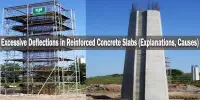Different flaws, such as subpar building materials and craftsmanship or flawed design, lead to construction problems. They fall into two categories: latent flaws and patent defects.
While latent (hidden) defects are hidden flaws or issues within the structure that are difficult to find, patent (visible) defects are flaws that can be found by reasonable scrutiny.
Latent defects may stay undetected for years, before finally making themselves visible and becoming patent defects.
Patent Defects in Construction
Patent flaws are flaws that can be seen clearly with the unaided eye, such as broken pipes, water stains on the walls, wall fractures, etc.
A legal document known as a practical completion certificate enables the client to occupy and make use of a structure. Before granting the certificate of practical completion, all problems that become apparent prior to the project’s practical completion should be fixed.
The defects liability period starts when the practical completion certificate is issued. The client may notify the contractor of any defects at any time throughout the defects liability or correction period. Once they are rectified, a certificate of making good defects (CMGD) (now called the certificate of making good) is issued to the client.
Before granting the contractor the final completion certificate, any flaws that have persisted even after the CMGD certification must be fully resolved. A final certificate is a statement made by the contract administrator indicating that all requirements of a construction contract have been met.
The final certificate’s value is based on the final accounts, indicating that any patent flaws have been fixed, any revisions to the contract price have been approved, and all claims have been resolved.
How to Deal with Patent Defects?
Since they are surface flaws, patent flaws are often addressed during the routine inspection and included in snagging. The contractor provides the snag list and updates it in a timely manner.
Latent Defects in Construction
Some errors and flaws in building projects brought on by mistakes in the design, execution, or materials might not be discovered for many years after the project’s completion or for a very long time after the defects liability period. These defects are called as latent defects.
A few instances of latent defects include a defective basement, wall movement or damage caused by insufficient wall ties, problems with weak concrete, mistakes made when reinforcing the structure, and building fractures caused by an insufficient foundation.
Latent faults are more challenging to locate and address than patent defects during the construction phase or defect liability period. Hence, there is no contractual right that obliges the contractor to rectify it.
How to Deal With Latent Defects in Construction?
After the defects liability period has passed, the building owner does not have a legal authority to require the contractor to fix any latent flaws that were discovered. However, as most latent defects are hidden weaknesses that are usually discovered after this time period, the owner may still be able to pursue compensation through a lawsuit for negligence or contract violation.
Making a dilapidation report to identify any potential latent faults is another option. An expert can inspect and predict potential future flaws brought on by shoddy planning or construction during the design or building phase. The contractor may place the blame for a latent flaw caused on the owner if there is no dilapidation report.
Other solutions include:
- Building insurance for structural damage and defects to roofs, walls or foundation.
- For design, craftsmanship, or material flaws that are discovered after the defect liability period, there is latent defect insurance.
When considering purchasing a house, latent flaws are a major issue. Although a seller is not required to reveal any existing obvious or hidden flaws in the structure, doing so is illegal and is referred to as fraudulent concealment.
It is recommended that anybody involved in a dispute over a latent defect, including the buyer, seller, property inspector, and real estate agent or broker, seek legal counsel from an experienced attorney.
















